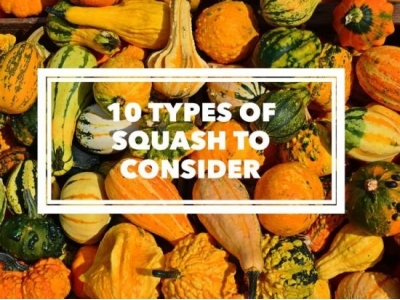10 Types of Garden Squash

Whether you prefer it steamed, sautéed, baked or in bread, squash is one of Mother Nature’s super foods. Squash is high in vitamin A, antioxidants and fiber. These members of the cucurbit family include summer squash, winter squash and pumpkins. Inedible gourds, also classified as squash, are used ornamentally.
CC Flickr photo courtesy of enil
SUMMER SQUASH
Summer squash is the easiest to grow of all the squash types. These plants produce prolific amounts of fruit, maturing in as few as 45 days, depending on the variety. Most summer squash are bush types, making them a good choice for container gardens.
1. Zucchini is a staple in many gardens. The dark green, variegated fruits are delicious steamed, sautéed, or baked in zucchini bread. Try ‘Ambassador,’ President Hybrid,’ or ‘Gold Rush,’ a yellow zucchini.
2. Yellow Squash have a mellower taste and softer flesh than zucchini. Try ‘Early Prolific Straightneck,’ Goldbar’ and ‘Early Summer Crookneck.’
3. Patty Pan or Scallop Squash have a charming, rounded shape and small form. Pick them when they are 2 to 3 inches across for the most flavorful fruits. Try ‘Peter Pan,’ Bush Scallop,’ or ‘Scallopini.’
WINTER SQUASH
Winter squash are the heavyweights of the squash family. They require a long growing season of 90 to 120 days, depending on the variety, and need lots of water and nutrients.
4. Butternut Squash mature in 100 days, and have a creamy, sweet texture, perfect for soups and sauces. Try ‘Butternut,’ ‘Waltham,’ or ‘Sweet Mama.’ “Emerald’ is a bush variety suitable for container gardens.
5. Acorn Squash have a meatier, slightly stringier texture than butternut, but are excellent steamed. Acorn squash are among the earliest of the winter squash, maturing in 70 to 80 days. They also usually have a bush form, requiring less space. Try ‘ Table King,’ or ‘Ebony Acorn.’
6. Hubbard Squash produce fruits weighing 10 lb. or more. Try old favorites, such as ‘Blue Hubbard’ or ‘Golden Hubbard,’ or try more exotic types, such as ‘Turk’s Turban,’ a colorful, turban-shaped squash.
PUMPKINS
Pumpkins take up a lot of room in the garden — 30 square feet or more per plant. Still, those cheery orange globes brighten the fall landscape like nothing else. If you’re going to go to the trouble of growing pumpkins – and it’s really not that much trouble – plant varieties not commonly found in the grocery store. Your kids will love them, the neighbor kids will love them, and fall decorating becomes as easy as a stroll through the pumpkin patch.
7. Heirloom Pumpkins like ‘Cinderella’ come in a variety of hues and shapes. ‘Cinderella’ has bright orange-red skin and a squat, ribbed shape.
8. Miniature Pumpkins fit in the palm of your hand and are a good choice for decorating, or for small children. Try ‘Jack Be Little’ and ‘Munchkin.’
9. Pie Pumpkins have a smooth, creamy flesh suitable for baking and cooking. Try two bush varieties, ‘Small Sugar’ or ‘Spirit.’ Both grow well in containers.
GOURDS
Gourds require 120 to 140 days to grow, but these inedible, hard-shelled squash make interesting birdhouses, cups or even sponges.
10. Cucurbita Gourds are commonly sold in grocery stores for fall decorating. They may be brightly colored with warts and bumps. Try ‘White Egg,’ ‘Orange Warted’ or ‘Mini Red Turban.’
Growing Squash
Choose a sunny garden area with fertile, well-drained soil. Amend the soil with compost or manure to improve the soil texture and plant the seeds two or three weeks after the last expected frost. Squash do not germinate well in cold, wet soils.
Plant the seeds in hills, placing six seeds in each hill, spaced six inches apart. Thin to three plants when they stand four inches high. Thin again to one plant per hill when the plants are 12 inches high, choosing the healthiest plant. Three plants are usually plenty for one family. Side dress squash plants with a few shovelfuls of manure or a generous handful of a balanced, synthetic fertilizer when the plants begin to flower. Spread the fertilizer on the soil 2 to 3 feet around the plant, covering the entire root system, advises Barbara Damrosch, author of The Garden Primer.
Squash need at least 1 inch of water per week to produce their big vines, leaves and fruit. Water them deeply two or three times per week, as needed, to keep the soil evenly moist.
Harvest summer squash when the fruits are young and firm. Older summer squash become fibrous and tough. Harvest winter squash and pumpkins in mid- to late-fall, but before the first hard frost. Summer squashes ‘Costata Romanesca,’ and ‘Golden Bush Zucchini’, as well as winter squash ‘Sunshine F1’ are delicious sliced and dried in a dehydrator, according to Carol Deppe, author of The Resilient Gardener.
Whether you have a large garden plot or patio containers, there’s a variety of squash for every gardener. If you have limited space, try summer squash or bush varieties of winter squash and pumpkins.
Có thể bạn quan tâm
 Growing Roses from Collected Seeds
Growing Roses from Collected Seeds Roses are probably the most popular flower grown by organic gardeners, given their beauty, scent, and hardiness.
 How to Grow Oleander
How to Grow Oleander Oleander is a shrub or small tree that blooms in summer with large, striking flowers in shades of red, white, light yellow, and pink
 How to grow blueberries
How to grow blueberries Fresh blueberries are a recent addition to Australian fruit bowls and are rarely grown in home gardens. However, as the succulent fruit becomes increasingly